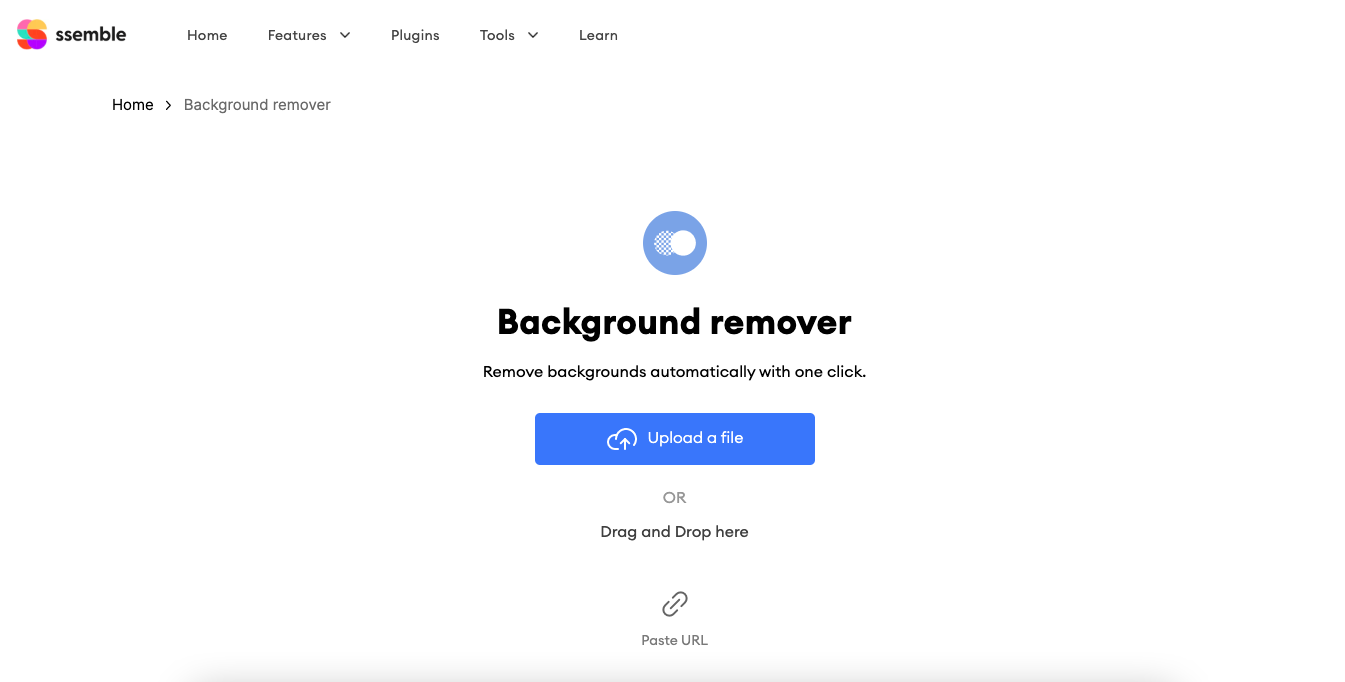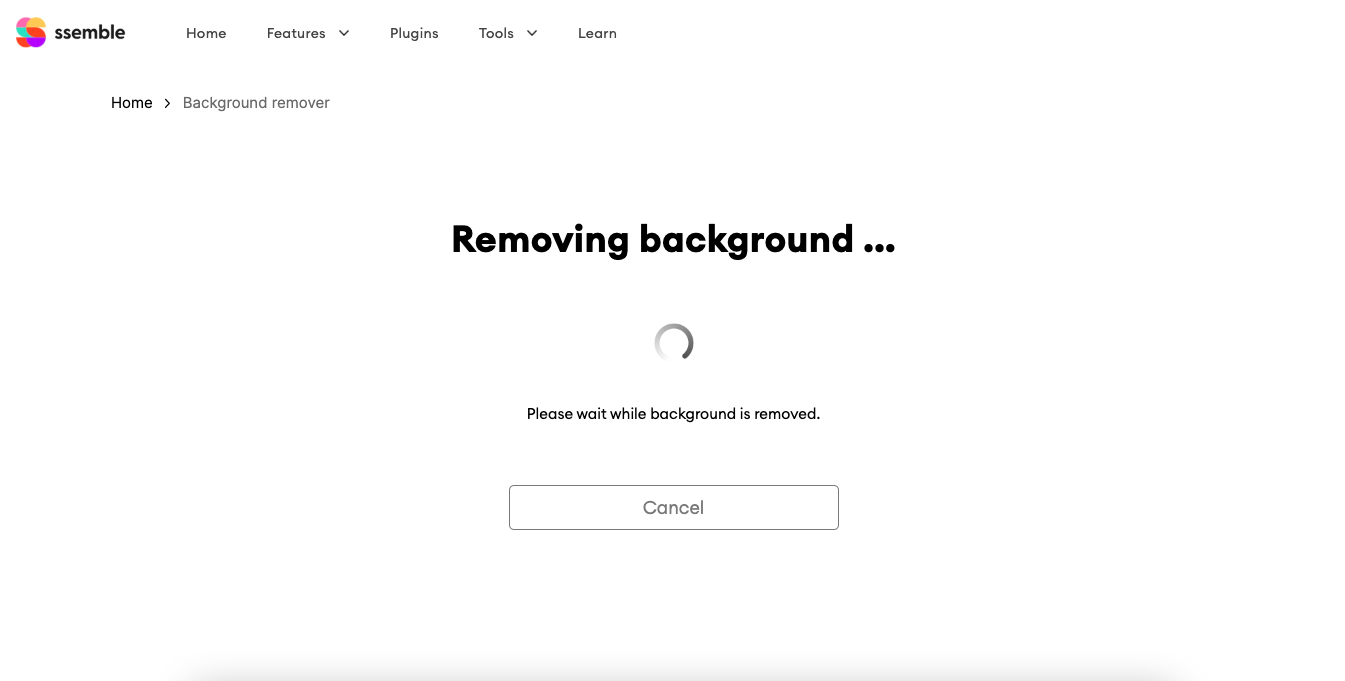Table of contents
Background removal is an essential task for graphic designers, marketers, and photographers. Whether you need to create transparent backgrounds for your product images, design a logo, or remove unwanted objects from a photo, background removal is a crucial step. In this article, we will discuss tools that you can use for removing backgrounds from images and practice using Ssemble’s background remover step by step.
What is a Background Remover?
A background remover is a digital editing tool that allows you to separate the main subject of an image from its background. Its primary purpose is to eliminate unwanted elements, such as complex or distracting backgrounds, and replace them with a solid color, transparent background, or a different backdrop altogether. By doing so, it helps to highlight the subject and make it the focal point of the image.
Background removers work by utilizing advanced algorithms and image processing techniques. They analyze the pixels in an image, identify the subject, and create a selection that separates it from the background. This process can be automated through artificial intelligence or performed manually using intuitive editing tools. Depending on the complexity of the image and the level of precision required, there are different types of background removal tools available, ranging from simple online editors to professional-grade software.
5Benefits of Using a Background Remover
1. Enhance Focus and Clarity
When it comes to conveying a message or highlighting a specific subject in an image, distractions can be detrimental. A cluttered or busy background can divert the viewer’s attention away from the intended focal point. By using a Background Remover, you can eliminate unwanted elements, ensuring that your subject remains the center of attention. This not only enhances focus but also improves the overall clarity of your image.
2. Create Professional-looking Visuals
Whether you’re a graphic designer, photographer, or social media enthusiast, presenting professional-looking visuals is crucial. Background Removers enable you to effortlessly remove distracting backgrounds, making your images appear polished and well-crafted. By eliminating visual clutter, you can create visually appealing content that stands out from the crowd and leaves a lasting impression on your audience. Once a background is removed you can easily use custom or stock images to change the scenery or backdrop. It allows you to use winter background images without having to deal with weather conditions when shooting. In the realm of real estate photography, the ability to effortlessly remove background distractions opens up a world of visual clarity, allowing the property’s true essence to shine through.
3. Seamlessly Blend Images
Sometimes, you may have the perfect subject captured in one image and a stunning background in another. Combining these elements can be challenging without the right tools. A Background Remover simplifies the process by allowing you to extract the subject from one image and seamlessly blend it with another background of your choice. This versatility opens up a world of creative possibilities, enabling you to create captivating and unique compositions.
4. Improve Branding and Marketing
For businesses, establishing a strong brand identity is crucial in today’s competitive market. Visual content plays a significant role in building brand recognition and conveying the desired message. By using a Background Remover, you can ensure that your branding elements, such as logos and product images, are showcased without any distractions. This consistency in visuals enhances your brand’s professionalism and makes a lasting impression on potential customers.
5. Save Time and Effort
Manual background removal can be a tedious and time-consuming task, especially when dealing with complex images. However, with a Background Remover, the process becomes significantly faster and more efficient. These automated tools utilize advanced algorithms to accurately detect and remove backgrounds, saving you precious time and effort. Whether you’re working on a single image or batch-processing multiple files, a Background Remover simplifies the workflow, allowing you to focus on other important tasks.
How Does a Background Remover Work?
A Background Remover employs sophisticated algorithms and machine learning techniques to identify and separate the foreground subject from the background. These algorithms analyze the color, texture, and edges of the image to accurately detect the boundaries of the subject. Once the subject is identified, the Background Remover removes the background while preserving the intricate details of the subject.
Some Background Removers also offer additional features such as automatic edge refinement, which ensures a seamless transition between the subject and the new background. This advanced technology eliminates the need for manual selection or masking, saving you time and effort.
The 3 Best Tools for Background Removal
There are several tools available for removing backgrounds from images. The best tool for you will depend on your specific needs and skill level. Here are some of the most popular tools for background removal:
1. Ssemble Background Remover
Ssemble offers a user-friendly tool for removing backgrounds from images. The tool uses AI to automatically detect and remove the background, making it easy for even beginners to use. It costs nothing and is simple to use.
2. Adobe Photoshop
Photoshop is an industry-standard tool for graphic designers and photographers. It offers advanced tools and features for removing backgrounds from images, making it the preferred choice for professionals.
3. GIMP
GIMP is a free and open-source tool that offers powerful features for removing backgrounds from images. While it may not be as user-friendly as Ssemble or Photoshop, it is an excellent option for those on a budget.
How to remove background with Ssemble
Step 1: Upload the image on the Ssemble Background Remover page
Step 2: Wait until Ssemble has done its job!
Step 3: You’re Done! Download your image simply from the page.
Applications of Background Remover Tools
Background remover tools find applications in various fields and industries. Here are some common areas where background removal is particularly useful:
1. E-commerce and Product Photography
In the world of e-commerce, high-quality product images are essential to attract potential customers. Background removers help create clean and consistent product images by removing distracting backgrounds. This allows the product to stand out, making it more appealing and increasing the likelihood of conversions.
2. Graphic Design and Marketing Materials
Background removal is a valuable tool for graphic designers creating marketing materials such as brochures, flyers, banners, and advertisements. By removing unwanted backgrounds, designers can focus on the subject matter and design elements, resulting in visually appealing and attention-grabbing graphics.
3. Social Media and Profile Pictures
Social media platforms have become increasingly visual, and profile pictures play a significant role in personal and professional branding. Background removers enable users to have clean and eye-catching profile pictures by eliminating distracting elements and highlighting the individual or brand.
4. Photo Editing and Creative Projects
Background removal opens up a realm of creative possibilities for photo editing enthusiasts and artists. By removing the original background, one can replace it with different scenes, apply artistic effects, or create composite images. This allows for imaginative and visually striking creations that evoke emotion and captivate viewers.
Best Practices for Background Removal
Regardless of the tool you use, there are some best practices you should follow for background removal. Here are some tips to keep in mind:
1. Choosing Appropriate Images
When selecting images for background removal, it’s important to choose ones that have clear subject-background distinction. Images with well-defined subjects and minimal overlapping elements make the separation process easier and produce better outcomes.
2. Maintaining Image Quality
To ensure the best possible outcome, work with high-resolution images. Higher resolution provides more detail and allows for precise selection and edge refinement. Avoid using heavily compressed or low-resolution images, as they may result in pixelation or loss of quality.
3. Refining the Selection
After the initial background removal, carefully review the selection edges. Fine-tune the selection by adjusting the tool’s settings or using manual editing options to refine the edges and improve accuracy. Pay close attention to hair, fur, or intricate details that require special care.
4. Fine-tuning the Edges
To achieve a seamless blend between the subject and the new background, it’s crucial to fine-tune the edges. Use tools like feathering or smoothing to soften the transition between the subject and the background. This helps create a natural and realistic appearance, making the edited image look more professional.
Final Thoughts
In the world of visual content, a Background Remover is an invaluable tool for achieving stunning, distraction-free images. By removing unwanted backgrounds, you can enhance focus, clarity, and professionalism in your visuals. Whether you’re a photographer, graphic designer, or a business owner looking to elevate your brand, a Background Remover can help you transform ordinary images into extraordinary ones. Embrace the power of Background Remover – Say Goodbye to Distracting Visuals and unlock a whole new level of creativity and impact.
FAQs
Q: Can a Background Remover handle complex backgrounds?
A: Absolutely! Advanced Background Removers utilize powerful algorithms and machine learning to handle a wide range of backgrounds, including complex and intricate ones. Whether it’s a busy cityscape, foliage, or intricate patterns, these tools are designed to accurately detect and remove the background while preserving the subject’s details. With their advanced capabilities, you can confidently tackle images with even the most challenging backgrounds.
Q: Will using a Background Remover affect the quality of my image?
A: No, a reliable Background Remover will not compromise the quality of your image. These tools are designed to preserve the integrity and details of the subject while removing the background. The advanced algorithms ensure that the removal process is seamless and doesn’t introduce artifacts or distortions. As a result, you can expect high-quality, professional-looking images that maintain their original clarity and resolution.
Q: Can I customize the new background after removing the original one?
A: Yes! Many Background Removers offer the flexibility to replace the original background with a new one of your choice. Once the background is removed, you can either select from a library of pre-existing backgrounds or use your own custom background. This customization allows you to create unique compositions that align with your creative vision or branding requirements.
Q: Are there any limitations to using a Background Remover?
A: While Background Removers are incredibly powerful, there are certain limitations to consider. For example, if the subject in your image has intricate details or transparent elements, the automated algorithms may struggle to accurately detect the boundaries. In such cases, manual touch-ups or adjustments may be required to achieve the desired result. Additionally, heavily blurred or low-resolution images may pose challenges for background removal. It’s important to choose images with sufficient clarity and definition for optimal results.
Q: Is Ssemble’s Background Remover user-friendly for beginners?
A: Yes! Ssemble’s Background Remover is designed to be user-friendly, even for those who are new to image editing. These tools often provide a simple and intuitive interface, with clear instructions and tutorials to guide you through the process. Additionally, Ssemble’s Background Remover offers automated features and presets that streamline the background removal process, making it accessible to users of all skill levels.







